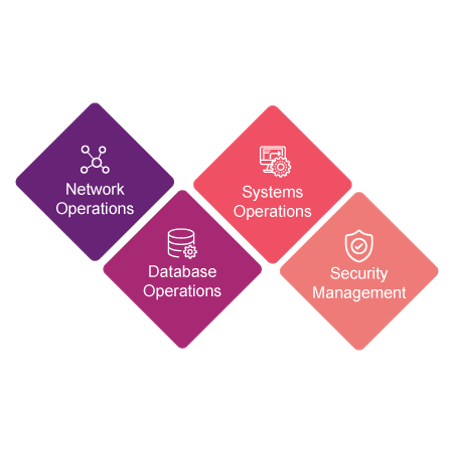
A service desk is the primary point of contact for the coordination of activities between the end-user and the IT service provider. In this blog, we will learn about the various operations of the service desks, classifications of the service desks in ITIL, the importance of service desks, etc. Let’s learn about the various aspects like importance, operations, etc, in the ITIL service desk.
Importance of Service Desks in ITIL
- It improves the efficiency of employees as the incident resolution times are greatly reduced with a functioning service desk in place.
- Service desk tools can be used for the accumulation of operational data to keep tabs after the implementation of the solution.
- Certain service support tools possess intelligence tools that create visualizations to allow the supervisor to identify the performance of the implemented solution.
- Integration of the service desk in an organization with the business process can increase the efficiency of operations and lead to significant gains in the long run.
- Advanced service desk tools and change management help the organization comply with the laid down norms for standards and efficiency, which can increase the potential of the company to get additional investments.
- Modern service desks are flexible and can respond to a variety of operational circumstances and provide support to convince the higher-ups to invest in modern ITSM platforms.
Operations Managed by Service Desk in ITIL
1. Network Operations
It is the ability to monitor the network connections and devices connected to the network remotely. The service desk has to monitor the changes, incidents, and traffic in the network and ensures that the network infrastructure is optimized for the operations of the organization.
2. Systems Operations
It is the ability to manage the core systems of the company. It includes monitoring the performance of the systems. Installing software updates, patches, and managing changes and support for different platforms used in the company’s systems.
3. Database Operations
It is the ability of the service desk to maintain the database by monitoring its performance. Reviewing the logs, managing the access, and changing control for certain database software such as Oracle.
4. Security Management
It is the ability to protect the organization from internal and external security threats. The duty of the service desk is to check for vulnerabilities in the IT infrastructure. Monitor the access logs, and correlate the data available with the security mandates.
Service Desks in ITIL: Service Desk Manager
In a large company where hundreds of requests are put through the service desk every day, a Service Desk Manager is needed to monitor the supervisors at the service desk. It is the duty of the service desk manager to perform the following activities.
- Managing the activities at the service desk and their supervisors
- Acting as a higher escalation point for the service desk supervisors
- Reporting to senior management regarding any major issues that could cause damage to the organization’s business
- Taking complete responsibility for all the incident management and request fulfillment activities that happen through the service desk
- Taking a broader role to handle customer service
- Attending the change advisory board meetings
Service Desks in ITIL: Service Desk Analyst/Supervisor
In smaller companies, a service desk analyst will also perform the role of a supervisor. Since the number of service requests will be very less. In larger firms, a dedicated supervisor may be needed to handle all the workload along with the analysts and monitor them. The following roles are performed by the service desk analyst:
- Ensuring that adequate levels of staffing and skill are maintained throughout the operating hours by assigning suitable shifts for the staff
- Performing activities that relate to Human Resources whenever there is a need for it
- Functioning as an escalation point when a problematic or controversial issue arises
- Representing the service desk at all company meetings
- Providing assistance to analysts during high-workload sessions
- Briefing the service desk staff regarding changes that may affect their work
- Liaising with the senior and change management
- Arranging sessions to increase the training and awareness of the staff
Classification of Service Desks in ITIL
1. Service Provided
- Call Center: The duty of the call center is to just receive the calls and forward customer requests to the relevant support group.
- Help Desk: The help desk receives calls and emails and tries to resolve the incidents.
- Service Desk: The duty of the service desk is to process requests for information, and resolve incidents and service requests.
2. Internal Organization
- Single level: A wide array of subject matter levels are present at the same level to solve service issues for premium customers.
- Multi-level: It is the popular type of service desk in an organization where the service starts at level 0 and goes up to level 3 depending on the priority and complexity of the service requested.
3. Size and Location of the Service Desks in ITIL
- Local Service Desk: They are located on-site, close to the customer, or in a nearby branch office.
- Central Service Desk: They provide IT support services from a central location that is not dependent on the location of the customer.
- Virtual Service Desk: The illusion of a single centralized service desk can be created with virtual service desks where experts from multiple locations around the globe are interconnected on a common platform with the help of the internet.
- Daylight Service Desk: It is a type of service desk that faces many challenges as its timings are dependent on the daylight timings of the customer to they provide service to.
4. Business Model
- Service Desk as a cost center: It is used in companies that are using the service on a fixed budget, and it is considered to be a cost to the company.
- Service Desk as a profit center: It is used in companies that not only want to recover the cost of investment in service desks but also want to make profits. The primary challenge faced is to balance profitability and quality customer service.
5. Ownership
- In-house: This type of service desk is run within the organization and the personnel at the service desk are employees of the company.
- Outsourced: This type of service desk is provided by a third-party service provider where the personnel is not an employee of the organization. They are employed on a contract basis by the company.
6. Customer Orientation
- Internal: Internal service desks are in charge of providing service support to the company to the different departments.
- External: External service desks provide support for customers who are using or who have purchased the company’s services or products.
7. Communication Flow for the Service Desks in ITIL
- Inbound: The service desk receives communication from the customer and then responds to it.
- Outbound: The service desk initiated communication with the customers in order to market new products or get them to register for a particular service.
Conclusion
The Service Desk thus improves the efficiency of employees and assists in the accumulation of operational data. And, helps to identify the performance of the implemented solution. Integration of the service desk in an organization with the business increases the efficiency of operations, leading to significant gains in the long run. Learn about more such practices and skills with ITIL 4 Foundation training, and gain professional expertise in service management.
Know more about Service Management best practices through Invensis Learning’s IT Service Management certification training on ITIL 4 Foundation Certification, SIAM Foundation, SIAM professional, VeriSM, etc.
















